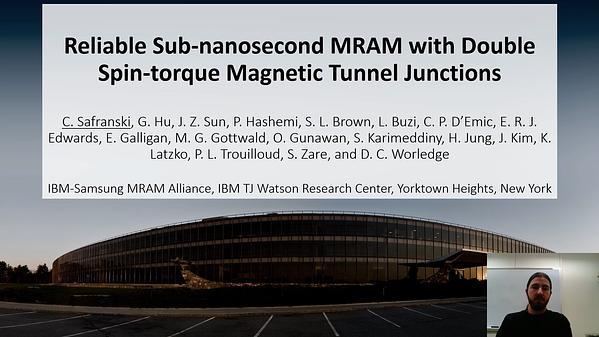Would you like to see your presentation here, made available to a global audience of researchers?
Add your own presentation or have us affordably record your next conference.
Quantum computation and cryogenic electronics have gained considerable importance in this last decade. Currently, a bottleneck for advancing it further is the power consumption of conventional electronic components, which is not adapted to the needs of cryogenic circuits. Perpendicular Spin-Transfer-Torque Magnetic Random Access Memory (p-STT-MRAM) has potential to comply with cryo-electronics requirements of low power. Previous works done on cryogenic temperature switching of STT-MRAM have assessed its characteristics and the Write Error Rate for different device diameters 1. The conditions to write an STT-MRAM are promising (0.7V at 9K with 200ns pulses, corresponding to a writing energy of 11.2 pJ) 2. However, the full integration of MRAMs into quantum processors demands a much lower operating voltage (below 0.1V).Therefore, we focused our research on engineering MTJs for low anisotropy to reduce the critical switching voltage VC and consequentially the write energy per bit Ebit. Our approach consists in changing the interface of the storage layer by adding an insertion layer as in Mg+Ox/X/FeCoB/W/Y/W, where X can be wedges of Mg, FeCoB and Y is permalloy (Py). This type of device can show high thermal stability at cryogenic temperatures (i.e.4K), while having no retention at 300K. This strategy allows the reduction of the storage layer anisotropy by at least one order of magnitude.
Figure 1 shows a current pulse phase diagram of a junction with Mg insertion. Upon changing the operation temperature the write current density JC for junctions with different insertion layers is varying as reported in Figure 2. Device diameter, composition and thickness play an important role in modulating the anisotropy. Tuning these parameters it is possible to bring the switching currents close to 20µA for a 30nm diameter device at 10K (red curve), corresponding to Ebit=1.2pJ. This can be further improved by modulating the required current density with composition as shown in the figure 2.
References 1 L. Rehm, G. Wolf, B. Kardasz, M. Pinarbasi, and A. D. Kent, "Sub-nanosecond spin-torque switching of perpendicular magnetic tunnel junction nanopillars at cryogenic temperatures", Appl. Phys. Lett. Vol. 115, p.182404 (2019).
2 Lili Lang, Yujie Jiang, Fei Lu, Cailu Wang, et al, "A low temperature functioning CoFeB/MgO-based perpendicular magnetic tunnel junction for cryogenic nonvolatile random access memory", Appl. Phys. Lett. Vol. 116, p.022409 (2020)

